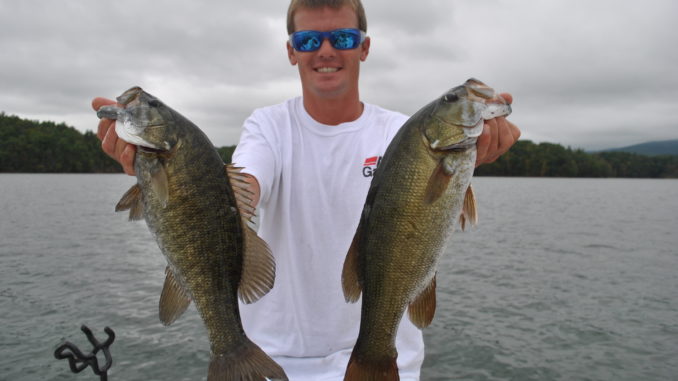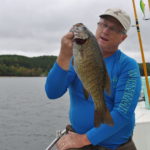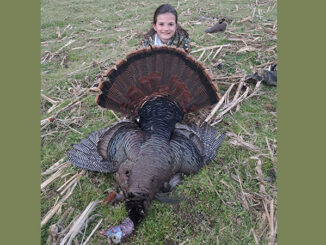
Drifting live baits and trolling plugs and spoons is not just for fishermen targeting striped bass
Colt Bass slipped a hook through the nose of a gizzard shad, and with a flick of his wrist, flipped the baitfish into the water. He started paying out line from the level-wind reel, with help from a planer board that was sliding to the side, away from the stern of his center-console boat, engaging the reel handle when the board was at the proper distance.
Bass, who grew up in Morganton and lives in Collettsville, could have been guiding striper fishermen on any number of reservoirs on the Catawba River within driving distance of his home: Rhodhiss, Hickory, Lookout Shoals, even Norman. But over his right shoulder, the early morning fog started to disperse, revealing mountains, tall mountains, sloping upwards to the Blue Ridge Parkway and the Eastern Continental Divide.
Not too long after the last of a half-dozen baitfish hit the water, the boat drifted over a long point, and one of the rods bent over abruptly, throbbing as a powerful fish fought the reel’s drag. In a couple of minutes, Bass slid his landing net under the fish and brought it aboard.
But it wasn’t a striped bass, not even anything remotely related. Bass scooped up the fish, unhooked it, admired its chunky, brown body, then slipped the 2 1/2-pound smallmouth bass back into the deep, clear waters of Lake James.
James is the uppermost reservoir on the Catawba River, covering 6,812 acres and impounding the upper Catawba and Linville rivers. It’s the deepest and clearest of the Catawba lakes and, aside from Lake Wylie on the North Carolina-South Carolina border, it’s the only one in North Carolina that doesn’t have a fishable population of striped bass.
But oh, do the smallmouths make up the difference. And it wasn’t too long ago that Bass, who cut his teeth fishing live bait for stripers on Lake Hickory and trolling spoons for walleye on Lake James, figured out that he could adapt those techniques and catch a lot of those big bronzebacks for which the lake is famous.
“This is striper fishing for smallmouth bass,” said Bass, who runs Colt Bass Fishing guide service. “A lot of the techniques for striped bass bleed over into this, and a lot of them work. Hey, fish are fish, no matter what kind they are.”
June is the perfect month for what has become a favorite technique for Bass: slow-trolling live baits over relatively deep water for smallmouths that often breach the 5-pound mark. The spawn is a month in the past, and bronzebacks have recovered and are hungry, moving away from the bank and toward the places where they’ll spend the summer.
“They start setting up in June,” Bass said. “They will run the bank for a couple of weeks after the spawn, and after we get the first good hot weather, they’ll come up for a couple of hours and feed in the morning before they move back out to deep water. On cloudy days, they may feed a little longer, but on a typical, sunny day, they’ll move out by 8:30 or 9.”
Bass usually starts in the Canal Bridge area, the man-made canal dug when the lake was impounded between 1916 and 1923 to connect the Catawba and Linville arms. He calls it a “funnel,” and “a natural fish attractor” that will normally feature a little current, especially if Duke Power is pulling water through the Bridgewater Hydroelectric station. He likens the canal’s bottom to “a camel’s back — up and down, down and up” where smallmouth can pull up and ambush passing baitfish.
He typically puts out six or seven rods, with two baits on each side of the boat fished vertically on down riggers and the remaining baits spread out away from the boat behind Original Clear Board planer boards. He eases along on his electric trolling motor, on either side of the bridge that carries NC 126 from Nebo to the southwest, across the canal and around the Linville River arm of the lake before heading back east toward Morgantown. He’ll ease from bank to bank, covering water, getting bites here and there.
“I will use baits anywhere from 2 to 6 inches long. I’ll put out two little 2- or 3-inch baits, threadfin shad — you’ll catch walleye on them on your downlines — and I’ll put out bigger gizzard shad for the smallmouths. These fish will suspend in 15 to 30 feet of water.
“It’s just like striper fishing. i want the wildest, jerkingest, hot-rodding shad I can find,” Bass said.
The last thing he does before leaving the canal is troll a couple of No. 6 Shad Raps through the area, picking up a stray smallmouth, walleye or white perch. When he leaves, with a half-dozen smallmouth up to 4 3/4 pounds caught, he’ll he head back to the Linville River arm, which is the deeper, clearer side of the lake with more of the rocky cover that smallmouths love.
He’ll concentrate on pulling Shad Raps and a variety of trolling spoons across deep structure along the channel, which he says is “very distinct.
“This lake is so deep, the fish are just structure-oriented,” he said. “It’s not a place where you can go down the bank and catch fish — especially in the summer. There are hundreds of points along the Linville that are always worth trolling over. Some days, they are down in the channel or along the edge, and some days, they are suspended level with the edges on either side.”
Bass trolls four rods at between 1.8 and 2.5 miles per hour, but he’ll have double rigs on two of the rods, with a Shad Rap and Sutton or Loco spoons on leaders of different lengths tied to a 3-way swivel. The other two will have a single spoon or crankbait. The spoons all be on 18-inch leaders and the crankbaits on 12-inch leaders. Everything is trolled on reels spooled with leadcore line. The line changes colors along its length, and bass said that it can sink spoons or crankbaits about 5 feet for ever color; he normally puts out four colors, so baits are at 20 feet.
“The lake is so clear, I use a lot of bright colors: chartreuses, oranges, pinks. It may be that you’re fishing so deep that natural colors don’t show up as well,” Bass said. “Spoons don’t usually work as well on overcast days., There are some days when all the bites will come on the spoon and some when they all come on the crankbait.”
Bass can crank the rigs up a few feet and lower them back as he trolls over different bits of structure along the bottom.
“I like to fish between major points that mark the outside of bays,” he said. “I love to fish all of the secondary points inside them.”
DESTINATION INFORMATION
HOW TO GET THERE — Lake James is the uppermost reservoir on the Catawba River system, with separate dams impounding the Catawba and Linville rivers, linked by a man-made canal. The lake is west of Morganton and north of McDowell, divided between McDowell and Burke counties. I-40 provides the best access, at Exits 91 and 94. Popular public boat ramps are Canal Bridge and Hidden Cove in Lake James State Park off NC 126, and Linville close to the mouth of the Linville River off NC 126.
WHEN TO GO — Smallmouth bass wind up their annual spawn in early May and spend several weeks in transition between postspawn and summer areas. Consistent action in deeper water begins around June 1 and lasts through the summer.
BEST TECHNIQUES — Slow-troll live gizzard and threadfin shad through the canal area at or before daylight, moving deeper as the sun gets up. Slow-troll live baits, spoons and small crankbaits across the ends of secondary points in larger bays later in the day, looking for fish anywhere from 15 to 50 feet deep.
FISHING INFO/GUIDES — Colt Bass, Colt Bass Fishing, 828-381-3426, www.coltbassfishing.com; Foothills Marine, Morganton, 828-439-9022, www.foothillsmarine.com. See also Guides and Charters in Classifieds.
ACCOMMODATIONS — Burke County Travel and Tourism, 828-433-6793, www.discoverburkecounty.com; Blue Ridge Traveller, 828-662-4282, www.blueridgetravelers.com. Camping is available at Lake James State Park, 828-584-7728, http://www.ncparks.gov/lake-james-state-park
MAPS — Kingfisher Maps, 800-326-0257, www.kfmaps.com; Duke Energy, www.duke-energy.com/lakes/facts-and-maps/lake-james.asp.









Be the first to comment